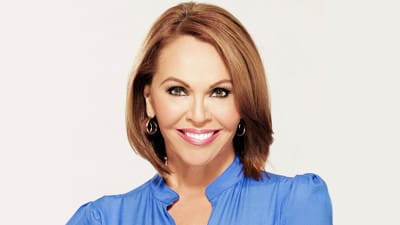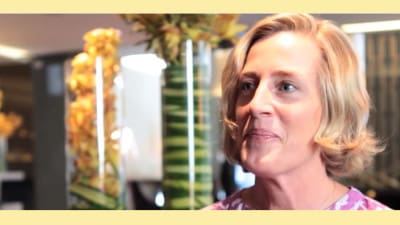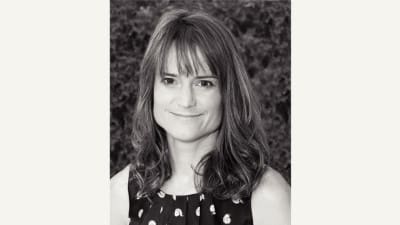With Diane Sawyer’s near-5-year-run on ABC “World News”, the spotlight is once again on the female news anchor and the progress that broadcast news has made in the past decade.
But in 1987, almost 20 years prior to Katie Couric earning a spot as the first woman to anchor a network broadcast, María Elena Salinas became an anchor of “Noticiero Univision,” the national Spanish-language evening news broadcast on Univision. Since then, she and her co-anchor Jorge Ramos have watched Spanish-language news go from a small enterprise to a major media player, a point that was driven home in 2007 when Salinas and others hosted the first-ever Democratic and Republican presidential candidate Forums in Spanish on Univision.
Also on Mediabistro


During the 2008-2009 broadcast season, “Noticiero Univision” averaged 2.4 million viewers each weeknight, its best performance ever. And the program’s audience continues to grow, notably among younger demographics, something that can’t be said for some of its English-language competitors.
Salinas, an Emmy-award winning journalist, is also co-host of the prime-time newsmagazine “Aqui y Ahora” and a syndicated columnist. She’s not afraid to offer opinions and analysis, often speaking out in advocacy of Hispanic-American issues, and is regularly counted as one of the most influential Hispanic women in the country.
Here, she talks to mediabistro.com about gender in the broadcast newsroom, making the transition from a tiny local station to network news, and the growing Spanish-language media market.
Name: María Elena Salinas
Position: Anchor, Univision Network News, co-host of “Aqui y Ahora” news magazine, and syndicated columnist.
Resume: Co-anchor of the national evening newscast “Noticiero Univision” and the primetime news magazine “Aqui y Ahora,” and referred to by The New York Times as “the voice of Hispanic America.” Began as a reporter for KMEX-34 in Los Angeles in 1981, and assumed the anchor chair of “Noticiero Univision” in 1987, where she has been since. She is also a radio analyst on Latino issues and is one of few Hispanic syndicated columnists in the United States, where her column is published in more than 55 newspapers in both Spanish and English. Her memoir I Am My Father’s Daughter: Living A Life Without Secrets — a best-selling Spanish-language book — was published in 2006.
Birthdate: December 30th
Hometown: Los Angeles, California
Education: She went to community college in Los Angeles for two years where she majored in marketing. After she began working in television, she went back to school to UCLA extension: broadcast journalism.
Marital status: Divorced. Mother of two beautiful daughters.
First section of the Sunday Times: “Week in Review.”
Favorite TV show: Anderson Cooper 360
Guilty pleasure: Chocolate and shoes.
How did your career get started in news?
First I worked in radio, in 1979, and then in 1981 I moved from radio to television, Channel 34 in Los Angeles. Back then it was a little tiny, tiny station. I was the only female. There [were] only two reporters, and I was doing everything. I was anchoring, I was reporting, I hosted a daily public address program live, and then on weekends I did an entertainment program, so I guess that’s the way it is when you work for a little station [laughs].
But my intention was not necessarily to go into news. I was working in radio before, and I had studied marketing. I was very much interested in what was becoming a booming Hispanic market in the advertising side, and I honestly thought that that was my way in. But once I began working in news, I became so obsessed.
So, how did you make the move from that local station to a national program?
When I started working at Channel 34, we didn’t have a network newscast. I was a contributor to the newscast, and at the end of 1986 there was a big shakeup in what was then Spanish International Network — now it’s called Univision, but the network at the time was called S-I-N, SIN. There was a big shakeup and half of the staff left and formed what is now Noticiero Telemundo, and as part of the new group let’s say, I eventually came on board to anchor the late night news. There was a one-hour late night newscast.
It was an interesting time for that transition. We were owned by Emilio Azcarraga of Mexico, and he had warned that Jacobo Zabludovsky, who at the time was news director in Mexico City of Televisa’s newscast, was coming over to take over and be news director of our newscast. Miami is a very political city, and at the time Mexican press was perceived as not being free, as being just a mouthpiece for the Mexican government, who in turn had a very close relationship with Cuba.
Basically we got a lot of backlash, and the headlines were, “The Communists are coming to take over our newscast.” So, half of the people left in protest, and of course it never materialized, it never happened. The protest actually worked, because Zabludovsky never came to the United States to take over our news department. But at that time, that whole transition is when I moved over from the local station to the network.
What did the landscape of Spanish-language journalism look like then compared to now?
At the beginning, people saw Channel 34 and the few affiliates that we had at the time as, you know, these little low-power stations with low quality that only undocumented immigrants watched. It was very difficult to cover, for example a presidential election, because we’d always have to be explaining who we were: “Channel 30-what?” You know, people just had absolutely no idea who we were.
People who came into the industry always saw Channel 34 and Spanish-language media as a stepping-stone to bigger and better things. [Latinos] figured this is where we might learn a little bit about the profession and then move on to, you know, real TV: ABC, CBS, NBC, CNN then was beginning to make a dent or to be heard. And what happened is little by little Spanish-language media has grown so much that now it’s the other way around. Now you see people from ABC, CBS and NBC moving to Spanish, because it’s now the fastest-growing media, or fastest-growing network in the country.
So it was very different back then. Very, very different.
Now, there are 50 million Latinos in the United States, as opposed to 14 million. Our buying power right now is $1 trillion. In Los Angeles for example, when I used to cover local politics there were no Hispanics at the local level at all, not in the Board of Supervisors, not in the Board of Education, not in City Hall. Now we have a Latino mayor, several assemblymen, several council members, and on the Board of Education and just everywhere.
And right now I think not only [has] the Latino buying power increased, but Latino political power has also increased to the point where we no longer have to give an explanation of who we are and what we do. Now the doors of the White House are open to us. Now it is the politicians who reach out to us in order to get to the Hispanic vote. During the last election debates at Univision, [we had] both Democrat debates and Republican debates and that was unheard of.
Let’s go back for a second. How did the transition come about as you coming on as an evening news anchor?
January of 1987, I was a network anchor for the late night show, and then in early ’88, a new news director came in and teamed up my co-anchor and I, Jorge Ramos. Jorge was already doing the 6:30 for a little over a year, and then I had been doing the 11:00 for about a year.
This was an 11:00 network newscast, because we didn’t have local news at the time in our affiliate. So they teamed us up, and we did both newscasts together. We’ve been together ever since, so for 21 years Jorge and I have been anchoring together. So I have been a network anchor for, well since 1987, so that’s 22 years.
There’s a lot of conversation right now about the ascension of the female evening news anchor because of Katie Couric in the last few years, and Diane Sawyer at “World News”. But you’ve been doing this for longer than both of them. Was gender ever a discussion when you first started?
You know, it wasn’t. The Latino society is very macho, even though when you think about it, [in] Latin America, we’ve had female presidents, and in the United States we haven’t yet elected a woman as president. However, in the news business I think that in a lot of Latin American countries you still have the male figure, which is a dominant figure, and if you ever do have a female anchoring a network newscast, it’s usually just a decoration.
It’s changed somewhat, not to the point where you have primetime news anchored by women, but for us it was automatically accepted, because I was actually there before Jorge was. I started working in 1981, he started working in 1984, and because it was never really an issue for us. It’s changed so much that in our network, women really have more power than men.
Univision’s vice president Alina Falcon is a woman. Our two vice presidents of news are women. All of our executive producers are women. Our chief editor is a woman. So we really do have a lot of women in management and mid-management positions here at Univision.
I know you’ve had a lot of big interviews in your career. Which do you feel was the most important?
That really depends on the moment. One of the most interesting interviews were with Pinochet. He never really had much to say, but the fact that he gave us the interview thinking that I was a Cuban from Miami who was going to agree with his politics, and was very upset, or uncomfortable when he realized that I wasn’t.
That was one of the very few interviews he did when he was a dictator. And then Subcomandante Marcos, which is the rebel leader in Mexico, we did a two-hour interview with him. It was the very first time that he came out of the jungles of Mexico into the capital to speak face to face — but not really face to face because he continued to wear a mask — with Mexican President Vincente Fox.
That was also a very interesting experience. I interviewed President Obama when he was the president-elect, and it was amazing — the reaction of people to that. “Wow, what was it like to see him?” I said, “Well, this is the third time I’ve interviewed him. Nobody ever said anything before.” But all of the sudden he turned into this person that is bigger than life. That’s why I say it really depends on the time that you do the interview. If you get the interview of the head newsmaker then, then that’s it. Then you’ve made it.
You’ve been described as someone who practices advocacy journalism. Do you agree with that?
Yes, I do agree with that. Some people say it as if it was something with a negative connotation, and I don’t necessarily see it as that because I think that sometimes what we do is that we end up becoming the voice of voiceless, and we advocate, not amongst ourselves, but in the general market, the English-language market, on issues that affect Latinos. I’ve had debates with people like Lou Dobbs, for example, on immigration, and what I would say is that what I do is actually ask for debate, because up to now it sounds like a monologue attacking immigrants and accusing immigrants for all the ills of this country.
So by contributing their side and by talking about the contributions of Latinos and immigrants, and just giving a completely different perspective of what is usually out there about immigrants, it’s to some people advocacy journalism, and if talking about the contributions of Latinos turns me into a journalist who practices advocacy, then I don’t mind, then let it be. I also write a syndicated column. I am very careful in my column not to get involved in partisan politics, but I do talk about issues that affect Latinos.
Do you think that bilingual news, particularly Spanish-language newscasts will continue to grow in the next decade?
I think so, because Latinos are continuing to grow. We’re supposed to be 25 percent of the population by the year 2050. I remember people telling me when I started working at KMEX, “You really should try to make a transition into English TV, because there’s no future in Spanish-language TV, because Latinos will assimilate.” We’re talking 1981, ’82, ’83. And look what has happened now. Not only is the Hispanic community the fastest-growing community, but Spanish-language media is the fastest-growing media, and our viewership continues to grow. I mean, who would think back then that our stations would be beating ABC, CBS and NBC in the ratings in places like Miami or Los Angeles?
That was unheard of. So, I think that those who assumed that there was no future in Spanish-language media were wrong. I mean Latinos have been assimilating little by little, but assimilation doesn’t mean leaving behind your language and your culture. They continue to speak Spanish because Spanish is the one thing that unifies all of Latinos.
Who would you consider your inspirations professionally in the industry?
When I started working actually, there were women that I admired, such as Jessica Savitch, and Diane Sawyer, believe it or not [laughs]. It’s interesting for anyone to wonder whether this country is ready for a woman to be anchor. I mean Katie Couric of course already proved that. But I think women have always been ready to do this.
It’s sometimes the psyche of the country that hasn’t been ready. Peter Jennings was definitely someone whose career I followed. He always showed not only journalistic excellence, but he always showed compassion in his brand of journalism, and that’s something that I always admired.
What are the opportunities like right now for young people who want to become Spanish-language journalists?
I think the opportunities are there, because Spanish-language media is growing so fast. And I put my money where my mouth is. I have a scholarship that comes out of my pocket that is distributed by the National Association of Hispanic Journalists for students that want to follow a career in Spanish-language media. So I do think there’s more and more students, especially young women even more than young men, that are following a career in Spanish-language media.
Not only is Univision growing, Telemundo, and there’s, you know, more and more Spanish-language networks and radio stations, but as far as publications, just about every major publication now has a Spanish version. I think media is realizing that they need to have content that Latinos can relate to.
This interview has been edited for length and clarity.







